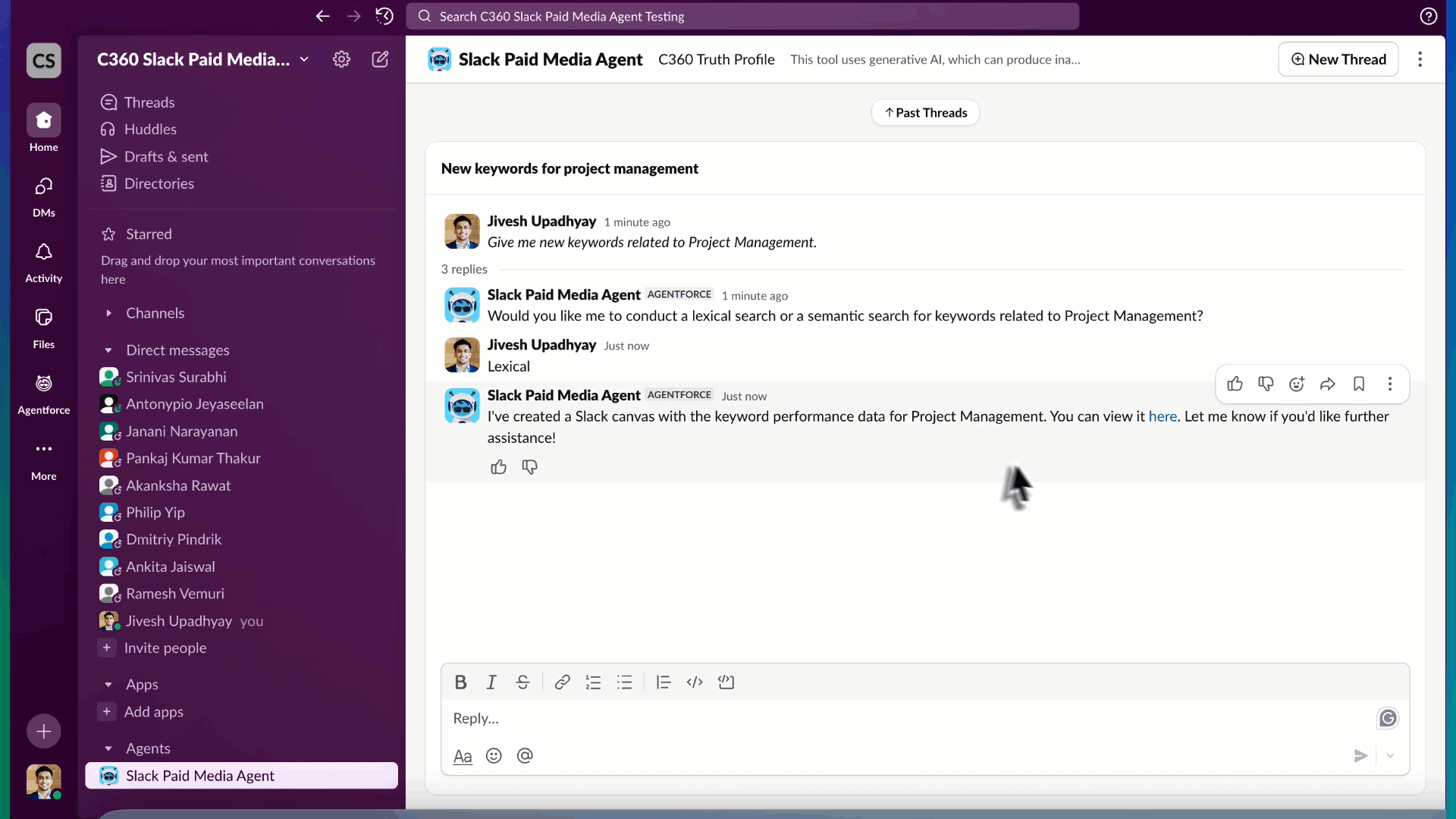Paid search campaigns are a digital advertising strategy where companies pay to appear in search engine results to drive targeted traffic to their website. Search growth is a numbers game: you need continuous keyword identification and testing to improve performance.
While optimizing paid search is a top priority for many marketing teams — after all, it accounts for 39.5% of the digital advertising market share, more than any other advertising format — they often lack the resources to maximize its impact. Teams often juggle managing thousands of keywords, campaigns and ad variations every single day. Limited resources, manual processes, disconnected data sources and competing priorities often hamper growth.
At Salesforce, our Slack marketing team set out to find a better way. They wanted to go beyond the keyword tools provided within Google Ads, where the majority of their paid search activities happen, to make authentic connections and get the most value. (Google dominates the search advertising market in the US with a 50.5% share of US search ad spending.) Since Slack solves a broad spectrum of use cases, the team looked to uncover a larger list of keywords that resonate with their prospects.
Learn how to optimize paid search campaigns
Sara Fefferman and Jivesh Upadhyay of Salesforce walk you through this Slack use case in their Dreamforce session.



Their answer? Agentforce. Hard-to-scale tasks like keyword expansion and paid search optimization are an excellent fit for agentic solutions. The team built a custom agent to help them optimize their paid search. The paid search agent uses the Salesforce Platform to identify new keywords for existing and new campaigns. The user interfaces with the results in their flow of work (which in this case is directly in Slack, of course) and organizes them for campaign use in just a few prompts.
For example, if a marketer wants to build on the success they’ve seen for keywords related to “collaboration,” the agent could identify and pull performance data for similar terms, such as “teamwork.” They can test these by using SEO and SEM insights. This goes beyond a simple keyword match. It’s a sophisticated understanding of related concepts that the Slack team can easily use to test new keywords.
The Slack marketing team has simplified and streamlined their optimization process by letting Agentforce identify new high-potential keywords, scale their velocity of testing and optimization, increase website traffic and ultimately drive more conversions.
“Keyword research can be an fruitful exercise, but it’s very time consuming,” says Josh Odenheimer, Director, Growth Marketing, Slack. “Given we are a small team, we don’t get to run this exercise as often as it should be done. The paid search agent solves this by cutting down the time to run this exercise, surfaces insights faster, and allows us to ultimately take action more frequently.”
How Slack built a custom agent for Slack
Let’s dive into the specific Salesforce platform tools the team used to to build their custom agent:
- Marketing Intelligence. Orchestrates the data, connecting, mapping and transforming search data into Data Cloud with marketing-specific API conectors and Semantic Data Model.
- Data Cloud. Powers the Salesforce Platform and delivers trusted, contextual data for Agentforce to activate real-time insights and intelligent action.
- Agentforce. Manages the flow of actions, finding relevant keywords, analyzing data sources, compiling suggestions and refining outputs based on conversational prompts.
- Slack. The agent is initiated in Slack. Once the data comes in, it publishes the data as a table into a slack canvas, consolidated in one place.

How Slack consolidated data management with Marketing Intelligence
The Slack team managed their data with Marketing Intelligence, the next-generation of marketing analytics built on the Salesforce platform. It automates data management by simplifying the ingestion, transformation and mapping from third-party sources. The Slack marketing team was able to connect their data sources using pre-built connectors called Data Pipelines into Data Cloud seamlessly with Marketing Intelligence.
The first step was to identify and consolidate available data. Unlike channels such as SMS, email, or WhatsApp, paid search data doesn’t live directly within the Salesforce platform. So, the team needed to find a way to ingest their Google Ads data into Data Cloud to make it accessible to the agent.
The Slack team brought in data from:
- Google Search Console, providing valuable search engine optimization (SEO) data, or organic search insights.
- Google Ads, delivering granular, keyword-level paid search data.
- Google Analytics, tracking web traffic generated by both paid and organic sources.
- BrightEdge, for market trends insights, competitor strategies, and content performance.
To build their search optimization strategy, they focused on:
- Understanding organic keywords and their performance
- Analyzing web traffic to identify optimization opportunities for desired outcomes
- Gaining deep insights from Google Ads data, including spend and other critical KPIs
Why you need a semantic model for success
A semantic model was essential to effectively integrate these data sources to answer strategic questions. Salesforce’s unified data layer, Tableau Semantics, provides business context to data across the platform.
Marketing Intelligence offers a pre-built semantic data model in Tableau Semantics, specifically for marketing. This model connects third-party sources like Google Ads to specific data categories, automating the transformation, mapping, and modeling into the semantic model, a traditionally technical, manual, and time-consuming tasks.
The Marketing Intelligence pre-built data model combines data from various marketing sources to calculate key metrics like Cost Per Click (CPC) and Click-Through Rate (CTR), essential for evaluating keyword and ad group performance.
This was a significant advantage for the team building the customer Slack Agent, as developers were accustomed to using Structured Query Language (SQL) for joining tables, a method that would have resulted in a rigid, difficult-to-scale solution limited to specific questions.
Ultimately, Marketing Intelligence provided several critical benefits:
- Accelerated data preparation: It streamlined the process of getting data into the right shape, offering a flexible foundation to answer diverse marketing questions.
- Automated data management: Marketing Intelligence handled data ingestion, modeling, and mapping with the Semantic Layer – removing significant development effort. This allowed the developers to focus their expertise on building the agent’s actions and its integration with Slack.
- Enhanced scalability and customization: While Marketing Intelligence was part of a larger solution, it significantly reduced development time and effort, leading to a more scalable and customizable agent.
By using the right tech stack, the team successfully built a custom agent that is easy to interact with in Slack, surfacing new keywords to test from one source, so they can act quickly and scale their efforts to optimize their paid search strategy.
Behold the magic of Dreamforce 2025 virtually!
Join us online for three days of learning, inspiration and fun. There’s nothing else like it.





























